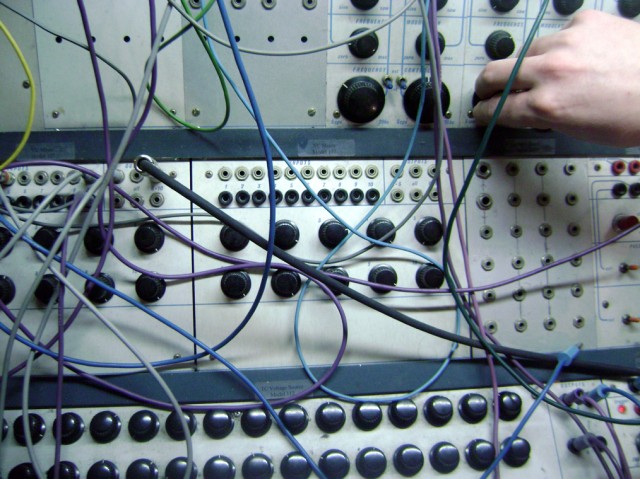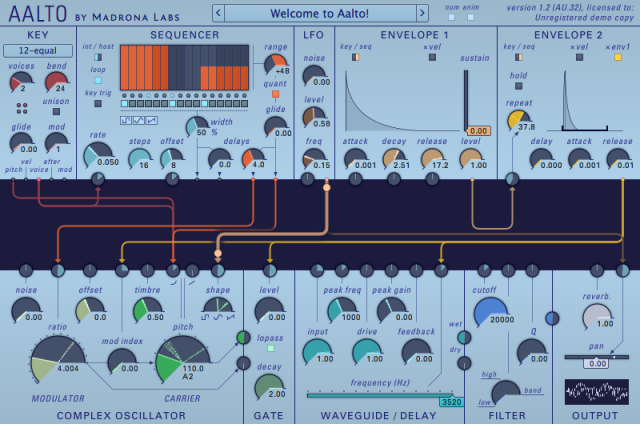Software can easily enough emulate, down to each knob and patch cord, a vintage synthesizer. But can a genuinely new software synth incorporate the ideas about instrument design beloved in a classic synth like the Buchla modular? How do you balance open-ended sound design with the sorts of limitations that give an instrument personality, limitations that inspire?
And could all of this be meaningful even for someone first discovering synthesis, who may never have seen or heard of a Buchla? (If that’s you, please don’t bail on us just yet!)
It’d be pretty pointless to celebrate the legacy of designers like Don Buchla or Bob Moog if you didn’t think that legacy would be carried on. Randy Jones, of Madrona Labs, is just the kind of person to watch. He’s the creator of the innovative multi-touch, tactile Soundplane hardware, as well as the semi-modular Aalto soft synth, updated this month. Madrona has just released Aalto 1.2. The banner feature: Windows support, meaning you now have full 64-bit (or 32-bit) support on Mac and Windows alike. There’s now really no reason not to try out the instrument, with free demos on each.
What makes Aalto special? It has a unique interface that focuses on sound, and semi-modular design that allows you to produce the sort of sounds a Buchla modular would – without trying slavishly to emulate that hardware in software. It’s something new. As Randy puts it:
The main UI element is a combination oscilloscope + dial that is totally new. It’s inspired by the Max/MSP multislider, as well as the idea “computers are so fast now, and promise so many new possibilities for visualizing sonic systems, why are we still making virtual knobs?”
Randy is reflective as well as inventive, so here are his thoughts on designing the instrument – as well as the most unique approach to copy protection (and cookie-cutter soft synths) I’ve ever heard. (And I do mean heard.)
Aalto, a Tool for Sound Designers; No Two Are Alike
I had two basic ideas: one was to build a softsynth that really encouraged people to make their own sounds, made it fun and easy. Also I wanted to make software that could duplicate some of the Buchla sounds programmed by Morton Subotnik– those wonderful Vactrol / LPG plunks, because I’d never heard that done in software before.
So I picked the Music Easel as an inspiration, not just in sound but in UI, making a small set of modules that would lead to a surprising variety of results.
Limitations are really key, and while Max/MSP and other general environments that try to do everything are very useful, I think musically there’s a lot to be said for making fixed instruments that you learn and don’t mess with. That way you don’t have this situation where everyone ends up with their own instrument. This idea goes for hardware as well as software…
I think good instruments are style-agnostic… hardware as well as software. Making something for a particular genre is just reacting to fashion, which is the enemy of expression.
It’s depressing how popular sample sets are. There are so many possibilities for making your own sounds—recording sounds well, processing and synthesizing them are all easier and cheaper than ever before. If you do electronic music, timbre is a crucial element– how can you buy a sound from someone else? That’s like a poet buying words from someone else.
Aalto is designed to be unhyped. Sit well in a mix. Good music makers have their own compressors, they don’t want a synth to decide to compress itself. Good music makers have their own effects, they don’t want a ton of reverb and delay slathered over every preset.
A precise tool that’s good for learning is also good for using. Knobs are marked with actual time and pitch units. It’s harder to learn synthesis if your knobs all just go from 0-1.
Nothing that affects the sound is hidden. Everything is one click away. Aalto has no menus. I think this makes it a softsynth actually good enough to perform with, not just playing notes but moving through patch space.
It’s easy to go off the rails. Enough rope to hang yourself. A whole world of bad sounds is available at the touch of a dial. Because without them, the surprising good ones wouldn’t be there, only the boring good ones.
The signal scaling to oscillator pitch is a handy knob– one turn of it totally messes up the musical intervals if you want. It’s also easy to get back to a default.
As a composer and performer I’ve been burned time and time again by copy protection, so Aalto doesn’t have any. You can make as many copies as you want, but only run one of them at a time. The registration is embedded in the plugin itself, so there’s no keyfile to worry about. Want to use Aalto at a friend’s studio? Copy it to your zip drive and use it.
Because of the embedded license info being available, I went and did something a little weird: each copy of Aalto makes a slightly different sound. No more than different units of a Prophet-5, but the filter cutoff and oscillator detune and some other parameters are slightly affected by your unique user data. So the sound of the synth is in a way made very personal to the license holder.
Though it’s not so easy to make a good one, it’s a lot easier to make a new softsynth than a new hardware synth. So why are softsynths mostly so boring? Why so little experimentation? I think more interesting things are happening on tablets, with weird audio-visual toys people wouldn’t have made without the interface being available. But the sound quality is not there yet with the tablets. We still have these desktop and laptop computers of amazing power that everyone is using for production… but where is the spirit of innovation that we see in the tablet space?
Being a Small Company
Little companies can do stuff unimaginable a decade ago, thanks to the internet for research and promotion, and the open source community for access to tools. There’s this big area of possibilities with companies like ours that have more of a craftsman than a startup vibe, are not in it to get bought out but to make things of value and beauty over the long haul. Certainly the monome folks are a huge inspiration to me here.
You don’t need a big team to make and promote cutting edge tech anymore, you just need a few really good people. What that means is that companies like ours can innovate and make a product for an audience of a few thousand, something that a Roland or Korg would never bother with, and have a sustainable business model doing that.
Hopefully, this gets the conversation started. Randy’s very open with his ideas, so we’ll be in touch; if you have other questions for him, let us know. And, of course, we should look at Aalto very soon.

